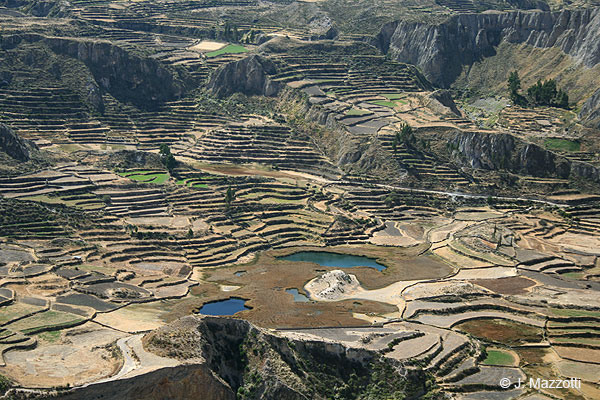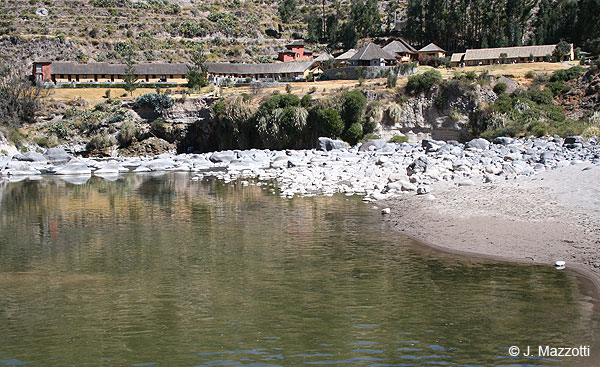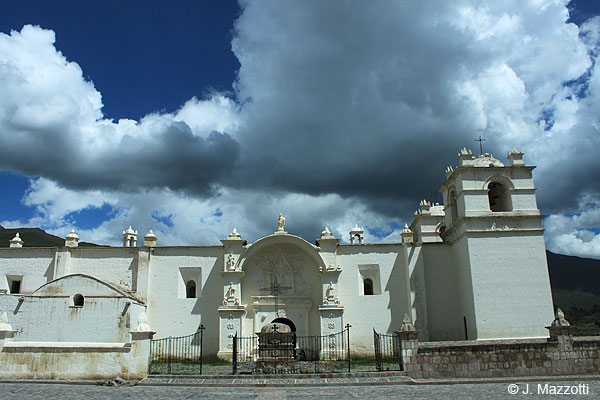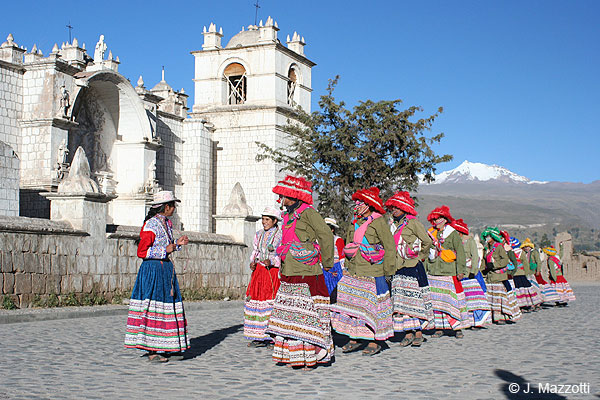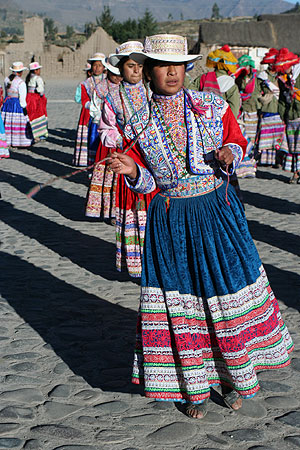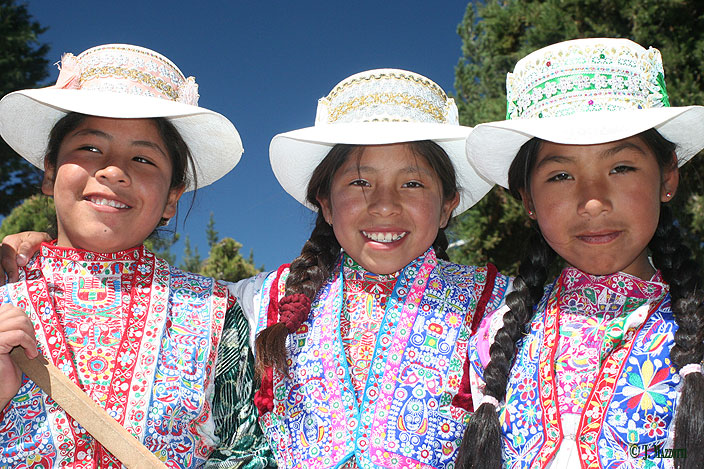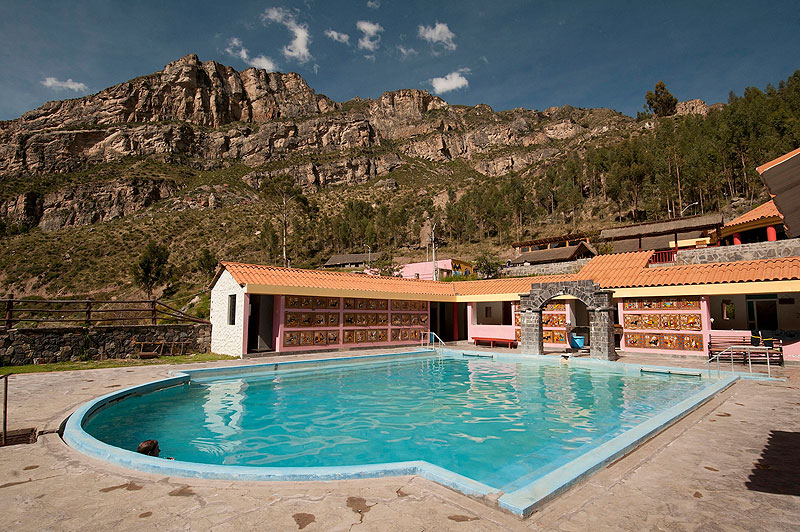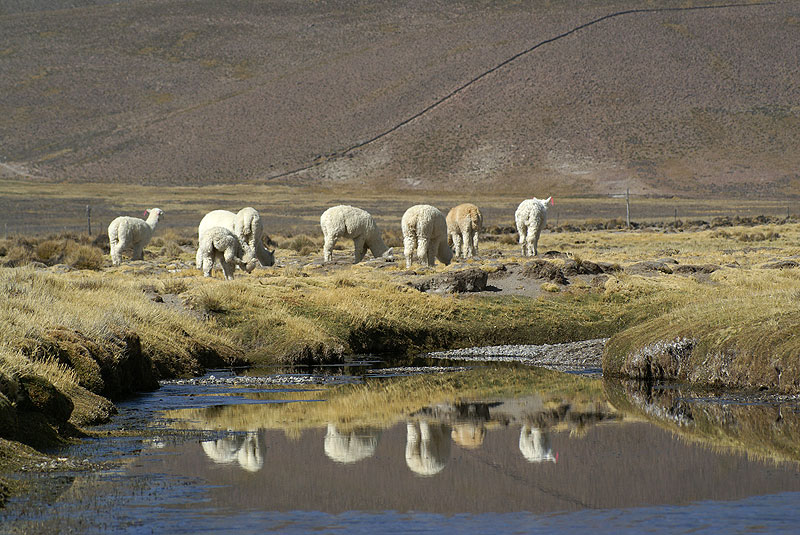Colca Valley
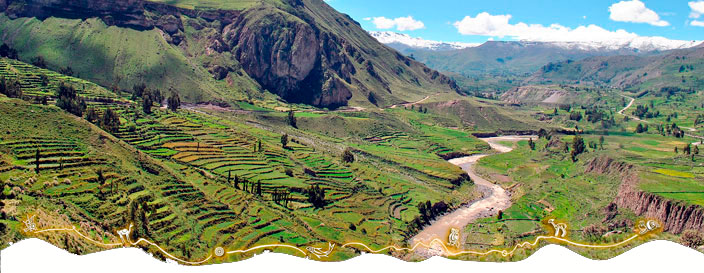
A destination that combines natural richness, living history, archaeological places, hot springs and adventure sports like canoeing, mountain-biking, mountaineering, hiking, ziplining and horse-riding. The Colca Valley is the most popular excursion from Arequipa.
The minimum recommended to visit is 2 days, combined with Colca Canyon.
Sights & Attractions in Colca Valley
Along the length of the valley there are fourteen colonial towns, where it is possible to see extraordinary examples of civil and religious architecture, stone houses with thatched roofs, and temples such as those of the Lari, Yanque, Cabanoconde, and Sibayo, which constitute true masterpieces of Mestizo Baroque art.
Arequipa’s and Colca Valley distinguishing seal is its living culture, an experience you definitely cannot miss out on. Whether it is about participating in ancient rituals, like an offering to the earth, or working in the fields next to farmers, forming part of the parades during one of the many festivals, or learning to native dances or Andean music, go ahead and do it because it is going to make you feel more like home. The best way of enjoying the hospitality and kindness of a place where friendship lives is through experiential tourism.
Colca Valley
The Colca Valley, also named Valle de los Collaguas, because the Collaguas were a pre-Inca tribe that lived in this area. Accomplished artists in textiles and stone carvings, during the colonial period, they worked as bricklayers and "hayllis" music composers. The current residents of this valley are heirs of the ancient collaguas crafts. It also emphasizes the beautiful and colorful clothing of its inhabitants, especially during the holidays.
Pre-Incas and Incas inhabitants of this valley used deposits known as "collcas" to store grain. The valley took its name as a result of the great number of these collcas. Lots of these collcas can be visited and one of the most important to visit is the Pumunuta collca, which is located in a frozen cave.
Throughout this region stands out and impresses the beautiful landscape that form the andenes (stepped terraces) which are earthen banks in a phased manner over the hills to be used in the planting technique used since the Incas, some with artificial irrigation and for other purposes rainfall. One of the most impressive aspects of the trip is the opportunity to admire the large number of pre-Columbian cultivated terraces (about 60,000 hectares) and irrigation canals that are kept in perfect condition from those times. Along the length of the valley are numerous hot springs.
Archaeological places in Colca Valley: Chachawani, Oqolle (Yanque), Choquetico, Wañaqasqa (Sibayo), Wapullja, Antaymarca, Paraqra and more.
The Colca Valley is a bird-watching recommended area, endemic birds and Andean birds.
Towns in Colca Valley
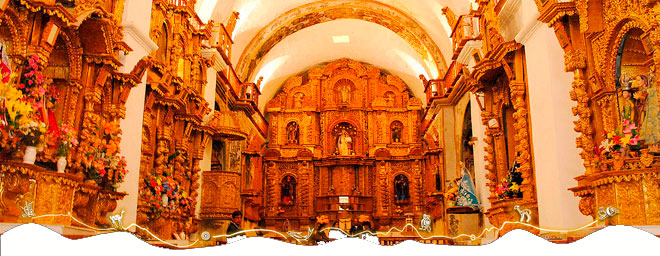
Along the length of the valley are fourteen colonial towns hosting extraordinary examples of civil and religious architecture, stone houses with thatched roofs and temples such as those of the Lari, Yanque, Cabanaconde and Sibayo, which are considered true masterpieces of Mestizo Baroque art.
In Yanque town is the Iglesia de la Inmaculada Concepción (church), National Heritage Site. Built in 1560, facade in white ashlar sculpted as filigree, mestizo baroque style. A jewel of the colonial architecture in Colca Valley.
The following towns are recommended to visit: (left shore river) Chivay, Achoma, Maca and Yanque, (right shore river) Coporaque, Ichupampa, Lari, Madrigal and Tapay, (high route) Callalli, Caylloma, San Antonio de Chuca, Sibayo, Tisco and Tuti.
Chivay (The Capital of Love)
Chivay town is the capital of Caylloma province, located 166 Km. from Arequipa City, 3,633 m.a.s.l., and is the entrance door to Colca Valley. The town id divided in 3 areas called Ccapa, Urinsaya and Hanansaya. Around the main square are located the commercial area, hostels, restaurants. Beautiful views of snowcapped peaks. The La Calera hot springs at Chivay are a wonderful way to relax after a day's touring. Astronomical observatory, located in Huayna Cápac street, with excellent views of Milky Way because no light pollution. Bus station, with daily bus services to Puno and Arequipa. The route to Arequipa city cross the Pampa Cañahuas and Salinas and Aguada Blanca National Reserve.
Sibayo (Stone Town) - Roural Tourism
Sibayo is located 37 Km. from Chivay (3,900 m.s.n.m.) is an ancient town built with stone and ichu grass, located in the Colca Valley. For different reasons, its inhabitants gradually abandoned the town, occupying a new place closer to the highway leading to Caylloma. However, Sibayo did not intend to disappear. Today, Sibayo comes back to life with all its mystery and beauty, in an experience tourism project that offers a stay amidst the arid and demanding nature of the highlands, and at the heart of a unique history of Southern Peru. Near to Sibayo(7 Km.) is located the Qollpa Pampa hot springs.
The town continued to be inhabited until the 1950s, because it was a meat and wool marketing center, both by the importance of its patronage festivals, linked to the presence of a temple built in 1692, which is a true jewel of mestizo architecture and art. In the 1970s, the town begins to move towards the bridge and highway, which were the necessary routes to the Caylloma, Arcata and Ares mines. The Handicrafts Cooperative was established in 1975, by 80 women, who began producing alpaca fiber clothes for the European market.
Nowadays, the inhabitants of Sibayo are livestock farmers and grow barley, potatoes and oca (sweet tubers). Sibayo originally comprised the ayllus (pre-Inca and Inca social units) of Collana Paque, Paraylas, Sibayo, Pachama Collana, Patacca, Pachama Cayao Pataca, Sibayo Pachama and Collawa Patasca. The term “Sibayo” comes from the Aymara word “shiva”, which means “canchón” or “barnyard”. The word “haya” stands for stone in the same language, while “jayu” is used to denote a traitor. Therefore, Sibayo would mean “the traitor’s barnyard”. Currently, the old Sibayo town shines again because of its embroideries, looms, handicraft workshops, colcas (cliff holes for storing food), under ever blue skies.
Its experience tourism offer guarantees relaxation, peace and contact with the living Collahua culture, a very rich pre-Inca culture, The houses are made of stone with ichu grass roofs, a warm combination of materials, as this is an intensely cold area. Proud of their heritage, the Collahua people preserve their traditions, continue speaking the Quechua of their parents and grandparents, and transmit it to their children. They have also preserved their clothes. Women usually wear a white blouse, multicolored long skirts, an embroidered vest with the “maquinasca”, a technique used from ancestral times, and a white hat with ribbons. The clothes of the Sibayo women are very symbolic, and it is possible to distinguish at first glance which of them are single, married or widowed. Single women wear two flowers in their hats, while married women only wear one flower, and widows wear a black bow.
The San Juan Bautista Temple
Sibayo’s temple is a monumental building with sillar (white volcanic rock), and its floor plan has the shape of a Latin cross. It is composed of a great nave crossed by the transept, with lower chapels at both opposite ends. The barrel vault roof has three lanterns or windows. Its solid lateral buttresses are a notable architectural feature in this temple, because Colca is a highly seismic zone.
Wititi Dance - Intangible Cultural Heritage of Humanity (2015)
The Wititi dance of the Colca Valley is a traditional folk dance associated with the beginning of adult life. It takes the form of a courtship ritual and is typically performed by young people during religious festivities celebrated throughout the rainy season. It is danced in troupes with rows of male and female couples performing a variety of steps to the beat of a band. Female dancers wear garments finely embroidered with colourful natural motifs and distinctive hats, while male dancers wear overlapping women’s skirts, military shirts, slings and ‘strong hats’. The dance coincides with the beginning of the agricultural production cycle and symbolizes the renewal of nature and society. The dance consolidates social ties and strengthens cultural identity with villages in the Colca Valley competing to produce the best ensembles, thereby continuously renewing the dance while maintaining its traditional character. The Wititi dance of the Colca Valley is learned through direct observation by youth and children in school and at private family gatherings, such as christenings, birthdays and weddings. At the national level, folk dance ensembles perform this dance as part of their repertoires.
Lady of Ampato - Inca girl mummy on Ampato Volcano - Johan Reinhard - Video
At its peak, from where the depression of the Colca Canyon can be seen, the "Lady of Ampato," was found, the funerary bundle of an Inca girl. Location: 173 Km. to the north of Arequipa (5 hours by 4x4).
Lodging and Tours in Colca Area
In Colca area there are hotels, from economic rates located in the towns, and luxury hotels and lodges are located in the countryside. The main hotels has thermal baths and hot springs.
The minimum recommended to visit is 2 days, combined with Colca Canyon.
Daily bus services and tours excursions from Arequipa city.
If you planing visit Arequipa, Colca and Puno, you have the option of tourist bus service for this route, more details ...





